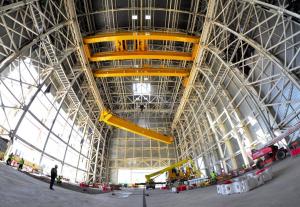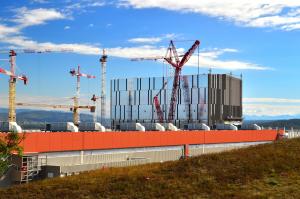Strong arms for 1,500-tonne loads
1,500 tonnes — or the equivalent of four Boeing 747s fully charged with passengers and fuel. That's what the recently installed Assembly Building bridge cranes will be capable of handling when operated together.

In June, a powerful crawler crane was positioned outside of the Assembly Building in order to raise and position the main elements of the overhead lift system. From its extended boom, a large hook passed through an opening in the roof and was lowered 43 metres to the basemat below, where four girders and their motorized trolleys were lined up for lifting.
The operation, which lasted some ten days, was a mix of brute force, high technology, and skill. Workers on the basemat below adjusted cables, slings, braces and shackles in order to perfectly balance the loads, while the crane operator—connected by radio from his cabin—slowly lifted each component. Surveyors used laser beams to ensure that everything was proceeding as planned and ropes were used to bring the largest components measuring 47 metres and weighing 186 tonnes into position.
The overhead crane will have a double role to play in ITER, first handling the machine components during the installation and assembly phase that begins in 2019 ... and then handling them again during the dismantling phase of the project.
Working together, the cranes will have the capacity to lift ITER's heaviest components, including the cryostat sections (the cryostat base will be the heaviest single load at 1,250 tonnes) and the sub-sections of the ITER vacuum vessel (approximately 1,200 tonnes each).
When the seven levels of the adjacent Tokamak Building are completed the rails of the overhead crane will be extended by 80 metres. At that point, the cranes will have a 170-metre crane bay to travel along in order to deliver ITER components to the assembly arena, before returning to pick up others in the Assembly Hall ...


